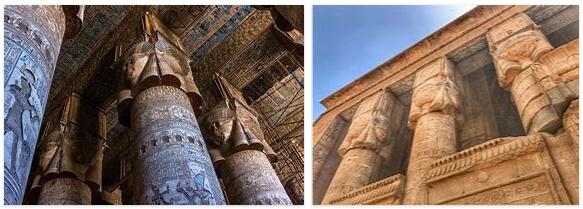Famous Temples in Egypt
Philae Temple (Hut-chenti)
Study trips to Egypt are characterized by insights into the time of the pharaohs and the world of the gods. The Philae Temple near Aswan on the island of Agilkia also testifies to this. The Hut-chenti (House of the Beginning), as the temple complex is also called, was originally located on the neighboring island of Philae, which is now completely flooded.
The pearl of the Nile
When the temple of Philae was founded cannot be exactly proven. The oldest entries come from the years 379 to 360 BC. At the beginning of the 20th century, the temple complex was flooded annually by the old Aswan Dam, which is why it was decided in 1972 to save the historic site by moving to the neighboring island of Agilkia, which is located higher up. After it was dismantled, it was rebuilt true to the original between 1977 and 1980.
The main building of the temple complex is located on the west bank of the island and is surrounded by other buildings worth seeing, e.g. B. the kiosk of Nectanebo I, the small Hathor temple or the kiosk of Trajan.
The legend of Isis
Most of the temples are dedicated to the goddess Isis. According to legend, Philae is said to be the place where she found the heart of her husband Osiris. He was cruelly killed by his brother Seth and his dismembered body parts were hidden across the country. Together with her sister Nephthys, Isis managed to find all the body parts and put Osiris back together. Although her husband chose a life in the afterlife, Isis became pregnant by him and gave birth to the god Horus. His birth and childhood are impressive to be admired in the form of reliefs in the birth house, the Mammisi. Since then, Isis has been revered as the goddess of love, fertility and redemption and, like the Nile, is considered to be the giver of life.
The temple of Philae is only approached by small water taxis and is the main attraction for trips to Aswan. On the way there, the imposing temple backdrop can already be seen from afar and the visitor begins to suspect what monumental building awaits him there.
Mortuary temple of Hatshepsut in the Deir el Bahari valley
Image: Wall paintings in the temple of Hatshepsut
Located north of Thebes and across from Luxor, the mortuary temple of Hatshepsut in the Deir-el-Bahari Valley is one of the most impressive sights on study trips through Egypt – a visit to this temple leads right back to the time of the legendary ruler Hatshepsut, almost three and a half thousand years ago the past.
Who Was Hatshepsut?
Hatshepsut, “first of the noble women”, was a female pharaoh from the 18th Dynasty of the New Kingdom, who after the death of her husband in the name of her stepson and nephew Thutmose III. took control of Egypt. Her reign for more than twenty years was a time of peace and economic prosperity. Nevertheless, after her death there were efforts to “erase” her from history in order not to destroy the continuous line of godlike male pharaohs – for example, a number of statues and wall paintings were destroyed or her name was overwritten with that of her stepson.
The temple
The temple complex is the best preserved in Deir-el-Bahari and is one of the most important of all due to its idiosyncratic architecture. The usual pylons in this limestone terrace temple have been replaced by open pillar halls, which are impressive as soon as you approach. Inside the temple offers several halls (including the “Punthalle”, the paintings of which depict their legendary expedition to Punt), chapels, many statues and, above all, fascinating wall paintings, which are often well preserved together with the bright original color and date back to their creation Move back thousands of years. The night’s journey of the sun is depicted on the walls of the newly restored Sonnenhof. The temple was probably built by steward Senenmut, who is considered a lover of Hatshepsut. Temple inscriptions say
Tips
Outside the summer months, the temperatures are more pleasant, but water and sun protection should definitely be in your luggage. The best time to visit is early in the morning or in the late afternoon. The impressive temple is a must-see when traveling to Luxor, offers views of the Nile Valley and Luxor and brings ancient Egypt to life!
Temple of Dendera
The Temple of Dendera is located in Upper Egypt, 55 km north of the city of Luxor. Dendera is an ancient Egyptian temple complex that was dedicated to the goddess Hathor. The temple of Dendera has been particularly well preserved and is one of the most important temples in Egypt. The reason why the old temple was so well preserved was that it was buried for a long time.
The goddess Hathor
So far no representations of the goddess Hathor have been found. It only appears in the ancient scriptures, and twice. In an inscription in the city of Efdu it is written that the Pharaoh had the Mammisi built for her and that she would therefore be loved by her. The goddess Hathor is also mentioned in connection with the lady of the horses in Dendera and with the goddess “Nebet-menit-Henmet-sescheschet”.
The excavations of the temple of Dendera
It has long been known that a temple complex must be located under a mound of rubble. However, the excavations did not begin until 1845. At that time, part of the main temple was first uncovered. The work was not continued until 1859 and the first publications gradually followed. The last inscriptions on the temple complex were not announced to the public until the end of the twentieth century.
The temple of Dendera and its mythological treasures
Inside the temple there is a representation of the birth of the sun on one of the ceilings. The crypts for storing cult images and cult objects are located on the outer walls. In the places of worship on the roof of the temple, celebrations for the death and resurrection of Osiris took place. A copy of the world-famous zodiac that Napoleon used to take with him and which can now be admired as an original in the Louvre in Paris is very well known. The columns, lion heads or the representation of Cleopatra and her son Caesarion are also beautiful. Anyone interested in ancient Egyptian mythology should take a lot of time for the temple of Dendera, because there is so much to discover there.



